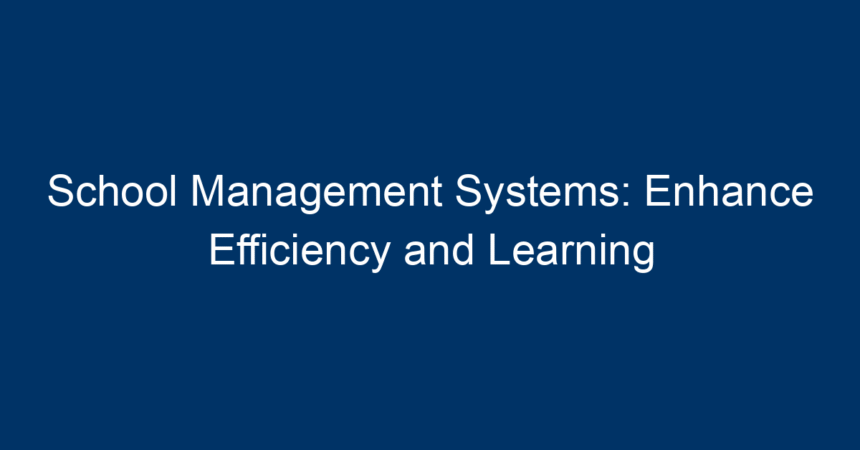In the digital age, the landscape of education continually evolves, driven by technology’s innovative landscape. One of the most transformative advancements in this field is the introduction of school management systems (SMS). These systems are designed to streamline operations, enhance student engagement, and improve educational outcomes. For schools looking to keep pace with modern demands, implementing a robust school management system can be a game-changer.
What Are School Management Systems?
School management systems are integrated software solutions that automate and manage a variety of administrative tasks within educational institutions. From enrollment to attendance tracking, grade management, and communication, these systems provide a comprehensive approach to handle school operations efficiently.
Key Features of School Management Systems
-
Student Enrollment and Management: Simplifies the admission process, making it easier for students and parents to enroll. The system allows for secure data storage of student details, reducing paperwork and manual errors.
-
Attendance Tracking: Automated attendance systems allow teachers to mark attendance easily and quickly. Parents can receive real-time updates about their child’s attendance, thus fostering greater accountability.
-
Grade Management: SMS provides a platform for teachers to record and manage student grades. This includes report card generation and performance analytics, enabling educators to track student progress effectively.
-
Communication Tools: Improved communication between teachers, parents, and students can significantly enhance the learning experience. SMS often includes features like messaging systems, notifications, and email capabilities.
- Financial Management: From tuition fees to budgeting, financial modules help schools monitor revenue streams and expenses. This ensures better financial planning and accountability.
Why Schools Need Management Systems
As educational institutions grapple with a myriad of tasks daily, the need for efficiency becomes paramount. Here are several reasons why adopting a school management system is crucial:
1. Increased Efficiency
Administrative tasks that once took hours can now be completed in minutes. By automating repetitive processes, school staff can devote more time to educational activities.
2. Enhanced Communication
A central platform for communication means that parents, teachers, and administrators stay informed consistently. This transparency fosters a supportive educational environment.
3. Data-Driven Decision Making
School management systems gather significant amounts of data that can be analyzed for decision-making. By identifying patterns and trends, schools can adjust their strategies to better meet students’ needs.
4. Improved Student Engagement
With features like online portals for students to access grades and assignments, students feel more involved in their learning. Enhanced interaction with teachers through the system can motivate students to participate actively.
5. Security and Compliance
Managing sensitive information, like student records, comes with a responsibility. School management systems ensure data is stored securely, meeting compliance requirements to protect student privacy.
Types of School Management Systems
Different schools have different needs, and consequently, various types of school management systems are available on the market. Here are the most common types:
1. Cloud-Based Systems
Accessed via the internet, cloud-based school management systems allow for flexibility and scalability. They reduce the need for extensive IT infrastructure and promote collaboration among users from different locations.
2. On-Premise Systems
Installed directly on school servers, on-premise solutions offer complete control over data security and access. However, they require a significant upfront investment and regular maintenance.
3. Mobile Applications
With the rise of smartphones, many school management systems now offer mobile apps. These applications allow parents and students to access important information on-the-go, strengthening engagement.
Choosing the Right School Management System
Selecting the right school management system involves careful consideration of various factors:
1. Identify Your Needs
Assess what functionalities are essential for your school. Whether it’s attendance tracking or grade management, identifying your core requirements will guide your decision-making.
2. User-Friendly Interface
A user-friendly interface is vital. The easier it is for staff, students, and parents to navigate the system, the quicker they will adopt it.
3. Scalability
Consider whether the system can grow with your institution. As your school expands, you need a SMS that can accommodate more students and features.
4. Support and Training
Opt for providers that offer comprehensive customer support and training sessions. These resources will ensure that staff can effectively utilize the system.
5. Budget
Analyze your budget carefully. While investing in SMS can provide long-term savings, it’s crucial to find a system that meets your needs without breaking the bank.
The Impact on Learning Outcomes
When implemented effectively, school management systems can lead to significant improvements in learning outcomes. Here’s how:
Enhanced Teaching Methods
Teachers can leverage data insights from the SMS to tailor their teaching strategies. Understanding individual student performance makes it easier for teachers to differentiate instruction.
Personalized Learning Experiences
With access to progress reports and assignments, students can take charge of their learning. School management systems empower students to identify areas for improvement and engage with their education more actively.
Efficient Resource Allocation
With detailed analytics, schools can determine where resources are needed most effectively. An SMS can highlight which subjects require additional support or which student demographics need targeted interventions.
Challenges in Implementation
Like any technology, implementing school management systems comes with its challenges. Awareness of these can help schools prepare:
1. Resistance to Change
Some staff may be hesitant to embrace new technologies. Providing thorough training and demonstrating the benefits can help mitigate resistance.
2. Initial Costs
While SMS can save money in the long run, the initial investment can be intimidating. Schools should budget effectively and explore various payment options from providers.
3. Data Migration
Transferring existing records into a new system can be time-consuming. It’s crucial to plan data migration carefully to prevent loss of important information.
Conclusion: Transforming Education through Technology
As educational expectations continue to rise, adopting a school management system is not just beneficial; it is essential for modern institutions. School management systems enhance efficiency and learning while providing schools with the tools required for improved communication, data management, and student engagement.
Actionable Insights
- Conduct a Needs Assessment: Evaluate your school’s requirements to find an SMS that aligns with your goals.
- Engage Stakeholders: Include teachers, parents, and students in the selection process to ensure everyone’s needs are met.
- Invest in Training: Allocate resources for comprehensive training sessions to encourage adoption and maximize the system’s potential.
- Review and Adapt: Regularly evaluate the impact of the SMS on your school’s performance and be open to making adjustments as needed.
In embracing school management systems, educational institutions position themselves on the cutting edge of technology, ready to meet the challenges of tomorrow’s learning environments.




